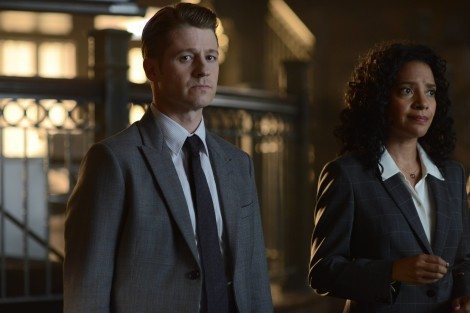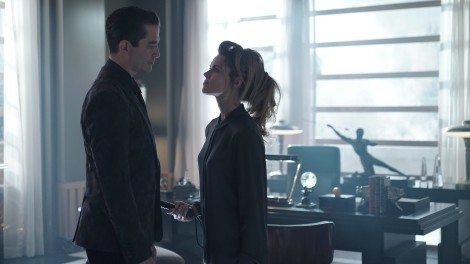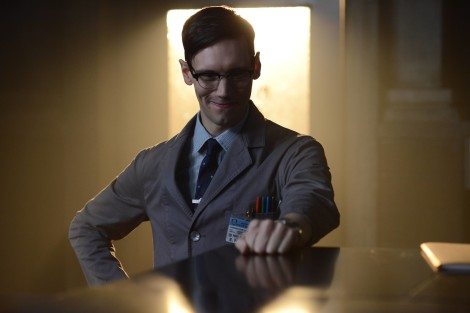Synopsis of 2×02: The maniacs are unleashed and massacre cops at the precinct, Bullock returns to the GCPD
Rating: ★☆☆☆☆
Let’s talk about death in Gotham and more generally, death in all televised crime procedurals. By nature of the genre, death is intrinsic in this form of storytelling. Crime procedurals assume death is generally both random and omnipresent, often a motivating force for protagonists who exist solely to deal with the after effects of death. That focus on death can lead to a seeming Laissez-faire attitude toward mortality but good procedurals have to place value on death to show the gravity of what their characters deal with.
Hannibal is a perfect example of this. Every case Will Graham and the FBI work in Brian Fuller’s dearly departed procedural is treated as a work of purpose. Will’s mantra, “this is my design,” emphasizes the sense of purpose killers bring to each life they snuff out. This style brings a sense of gravity to the deaths Will investigates as well as a horrific sense of characterization to the murderers he tracks. Bad procedurals often don’t give death that same sense of value. This leaves death not as a struggle, not as a mortal force, not as an ending, but as little more than a motivating force, a story point. Bad procedurals take death out of storytelling, it turns it into a box waiting to be checked on a hack screenwriters’ notepad.
This probably sounds like I’m going to rail on Gotham and I am, but I’m also not. Gotham’s second episode of the season, “Knock, Knock” shows the series at an impasse, divided between two vastly different ideas that have polar opposite views on how to deal with shuffling off the mortal coil.

Let’s start with the good. Bruce is still obsessed with his father’s cave beneath his house but Alfred doesn’t want Bruce to become consumed in Thomas’ quest. He smashes Thomas’ computers in front of Bruce and the hurt young Master Wayne fires his butler. Ultimately, Bruce realizes he still needs Alfred and tells him that the only way he can keep Alfred on staff is if they’re both willing to move forward in their quest. This motivates Alfred into building Bruce a support team.
He confronts Lucius Fox and blackmails the engineer into helping with the cave. It’s an electric scene, showing the threatening nature of the new Alfred, one who always has an element of violence to everything he does, but that threatening swagger belies true care for Bruce. The characterization “Knock, Knock” posits for Alfred, a father-figure terrified of letting his surrogate son lose his life and soul to a fruitless quest, is potent, new, and the best thing the show has done with the characters in Wayne Manor. It is a great, caring, empathetic take on these characters, one passionate about defending the sanctity of a life still developing.
That takes us to the worst part of “Knock, Knock,” which is the police and criminals plot. We’re going to have to get a couple things out of the way before we dig into things. First, Jerome is often awful. Actor Cameron Monaghan got a lot of credit in Season 1 for vaguely looking like what a child Joker would look like but as he’s asked to perform dialogue and emote, he’s revealed as a resounding failure. He’s trying to do Jack Nicholson’s Joker but with lines from The Dark Knight and he can’t handle either, but the show desperately wants him to send chills up your spine. Instead, he feels like a creepy Demetri Martin, more like a nebbish teen brother desperate to get a laugh than a nihilistic would-be-mastermind.
Second, Theo Galavan’s plot still makes no sense. He’s not getting any screen time as the show runners feel so drawn to showing off the maniacs instead and so his plan doesn’t feel substantial. Theo just feels like an agent of chaos and little else but the show wants him to feel like the puppet master of a grand conspiracy. He’s effortlessly sending his minions out on tasks and setting up hits but he’s empty, dull and grating.

With that said, we need to focus on what happens here, which is basically what a 13-year-old-goth Quentin Tarantino would come up with for a Batman story. The maniacs throw people off the roof of the Gotham Gazette, try to light a bus full of cheerleaders on fire and, at the show’s climax, walk into a police precinct and murder everyone inside. It’s nothing but death, shock for the sake of shock, empty pathos for the sake of no one and nothing. This is death done the worst it can be done. In the final 15 minutes, 30 people are shot on-screen. There’s nothing to say for it other than it’s meant to be shocking. It’s not. It’s empty and bloodless, poorly thought out, and even more poorly executed, and in almost shockingly bad taste.
It’s not my place to write about this in the context of months of police violence but it’s genuinely hard to divorce images in the news of police violence from seeing a group of people in police uniforms fire shotguns into a crowd of innocents for several minutes. Gotham isn’t a smart enough show to have anything to say about police violence, gun culture, crime, or race but the images it use evoke a brutal daily reality in America today and these are both powerful and profoundly empty-headed. That lack of caring for the bodies it so casually tosses aside, including the last remaining woman of color in the cast, casts a scar across a show that should be desperate to hook viewers after a rocky first season.

Death hangs over “Knock, Knock” and ultimately, the casualness of the climax’s massacre casts a pall over everything this season has tried to do. Yes, there are bright spots here but this is Gotham at its worst, throwing aside characters, ideas, and bodies for dime-store pathos and non-existent character development. It’s early in the fall season but so far, I can’t think of an episode more poorly thought out than this one.